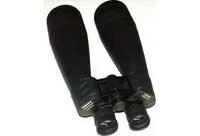The Binocular Site
Getting the Big Picture with Giant Binoculars

Like a lot of magnification technology, giant binoculars were originally developed for the military. These binoculars feature a super large objective lens size for maximum light collection, making them one of the best choices for astronomy and other low-light use.
While lens sizes vary, typically giant refers to those 70 mm and up, with 100 mm being perhaps the most popular option. When compared by lens size, and assuming magnification is the same, binoculars with 125 mm lenses can reveal double the stars seen using an 80 mm lens. Even on the lower end, 16x70 binoculars may show 600,000 more stars than 16x60 sets.
When Size Matters
Naturally the barrels of these binoculars are often long, and the entire unit tends to be large to contain the prisms and other mechanisms that make best use of the large lenses. As a result of their size, many giant binoculars are quite heavy. They can easily weigh in at 20 to 30 pounds, and are almost always meant to be mounted on a tripod or other device.
They simply are not comfortably used in hand for long periods. Although you will not want to carry giant binoculars while hiking or hunting, they are excellent for sky-gazing, offering a two barrelled design that for many is more comfortable than the single barrel telescopes, particularly when examining galaxies for long periods.
Apart from lens size and weight, you will want to consider magnification and ultimately field of view (FOV). As with all optical devices, very high magnifications result in smaller fields of view. When you want to observe a broader range of night sky, you may find using a lower magnification is helpful. Many giant binoculars offer interchangeable eye pieces with various magnifications; that way when you do want to take a closer look at stars within a universe you've spotted, you need only switch the eyepiece and focus once again.
Oberwerk offers an excellent set with its Giant Long Range Observation Binoculars. At a weight of 26.5 lbs, this device comes with Oberwerk's own tripod. It includes triplet objectives, which maximize light use, and fully multi-coated optics to eliminate reflections. With its 25x eye pieces, the FOV is 44 m, and with its 40x eye pieces, the FOV is 26 m. The Giant Long Range Observation Binoculars also offer a good long eye relief and adjustable inter-pupil-distance.
Lens Quality Is Just As Important As Size
Not surprisingly, lens quality becomes even more important when objective lenses become giants. Not only do you need big diameters, you need good quality lenses. With bigger size, there are more opportunities for distortions.
If possible, take a good look at giant binoculars while considering them, so you can get an idea of their lens quality. Many models will have double or triple lenses to help prevent any aberrations and make best use of light. Higher end, more expensive binoculars are worthwhile when objective lens size and quality are top-notch.
Optical quality is also kept high through the use of coatings. With extra large lenses, and as above, perhaps two or three of them, each can be coated to eliminate reflections. Again, you may find more expensive models make the extra investment quite worthwhile when the are fully multi-coated. There just is no excuse to buy giant binoculars that don't have coatings for best lens use.
Other Features And Considerations
Giant binoculars sometimes offer the same features found in standard sized models. For example, Barska has giant zooming binoculars called Gladiators, which have 70 mm lenses and magnify from 12x through 36x. Celestron has their SkyMasters, with a 100 mm lens and individual focus for those who prefer it, although some users have found these devices can arrive with poor collimation and low quality optics.
Barska's Cosmos binoculars are actually waterproof, and have extra long eye relief, while weighing only about eight pounds. On the more unique side, some giant binoculars offer a 90” viewing angle. Alternatively you might want to consider higher end mounts with angles that can be adjusted for comfort. Despite the added expense, these may be perfect for you during long-time use.




